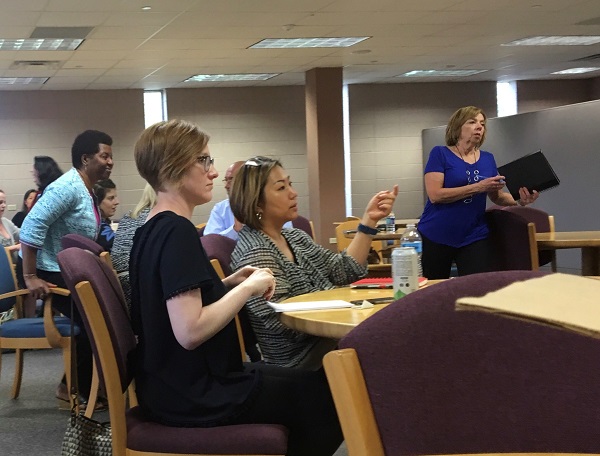Spring MUG session highlights VoiceThread, Moodle Groups
As part of its ongoing effort to explore and share new instructional tools, the Department of Distance Learning presented information on Moodle Groups and VoiceThread March 26.
About 30 instructors and staff members took advantage of the information session, which afforded the opportunity to hear not only from support experts within the department, but also from other instructors across disciplines.
Moodle Groups
Many instructors are familiar with and are actively using Moodle Groups and Groupings.
Marissa Lajaunie, an instructor in Allied Health, said she’s used the Group function for students who need extra test time, allowing her to adjust settings for the group instead of each user.
Other instructors gave examples of how the function allowed them to cluster students to collaborate, pair them randomly for group projects, or separate out their various course sections for each semester.

Instructional Designer Carey Hamburg led the presentation and discussion on Moodle Groups and Groupings, outlining when each is useful and how to properly create them.
In addition to uses brought forward by instructors in the room, Hamburg added the functions could help instructors parse out course work or resources over the span of a course, or help in restricting or allowing access for an Academic Coach who may be helping with a course.
He provided a few tips based on feedback from those who have used Groups.
- Ensure “include only Active Users” is selected when creating your group. Otherwise, all students, even those who may have dropped the course, will be included in your list.
- Instructors can create groups and populate them later, but groups must be created to see group options, including activity allowances and restrictions.
- Instructors must add themselves to discussion groups to allow students to reply to their comments.
- Be cautious with naming conventions. Although a group may be set up so that members cannot see others in the group, the group’s title can be visible.
Find more information and instructions on Moodle Groups and Groupings at docs.moodle.org/31/en/Groups.
VoiceThread with Moodle Groups
Political Science instructor Dr. McKinzie Craig Hall shared how she’s used the integrated VoiceThread function in Moodle to motivate research and facilitate collaboration in her hybrid Crime and Pop Culture course.
Her course was inspired by the popularity of true crime documentaries and podcasts, like Serial.
Hall said she wanted students to see how they could expose larger social policy issues through smaller narratives, with an end goal of having students deliver their own podcasts.
Hall’s challenge was not only teaching students the curriculum, but also the technology.
She began with a simple, ungraded assignment: introduce yourself to your group mates.
This allowed she and Instructional Designer Angela Lee to troubleshoot with students and address issues that would have otherwise been problematic.
They found:
- Instructors must use the “add external tool” function to link course work to VoiceThread, versus adding the link in Moodle. Students will not find their assignments unless they use this integration function.
- If students do not hit “submit” for their assignments, instructors may be able to access the work, but will not be able to grade it through VoiceThread.
- VoiceThread allows students to record directly to VoiceThread or upload from outside sources, like Garage Band or Audacity.
Lee said she and Hall plan to sit down at the end of the semester to review what worked and what didn’t in the process.
“There’s always more than one way to do something,” she said.
For instance, Hall said she had to find a workaround for the grade recording process between VoiceThread and Moodle.
Following the presentation, Hall said once they debrief on the semester, she hopes to transition the hybrid course to a 100-percent online offering.
“I’ve been pretty impressed with how engaged (students) are,” Hall said. “They’ve actually gone above and beyond what I was expecting, especially for the first time I’m doing this.”
To learn more about how to integrate these tools into your courses, reach out to us at distancelearning@louisiana.edu. Join the Distance Learning Faculty Facebook group to receive notifications about upcoming trainings and continue discussions on various tools and topics.
